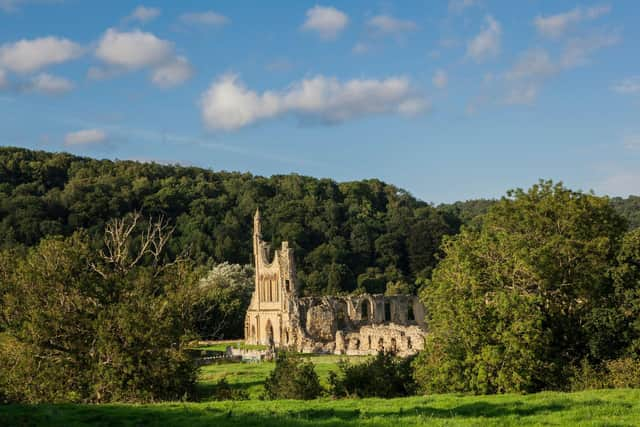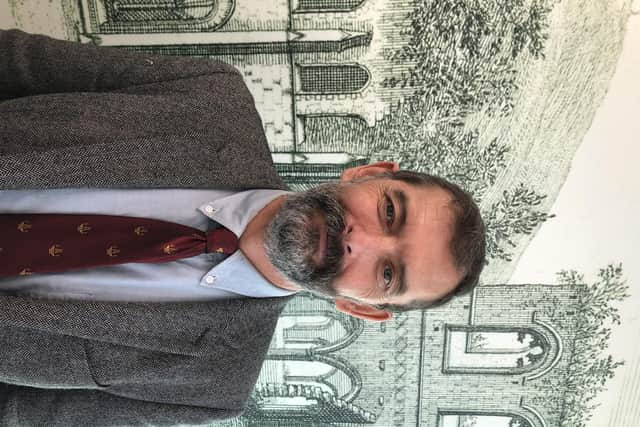English Heritage to host ghost story tours at Byland Abbey, Roche Abbey, Rievaulx Abbey and more
At least that is what has been written into history - just as tales about apparitions of saints in the cloister at North Yorkshire’s Rievaulx Abbey can also be found in medieval literature.
Leeds-born Dr Michael Carter, a senior properties historian at English Heritage, regales these stories with an obvious sense of wonder, one that he will hope to pass on to others over the coming weeks when visiting the region’s monastery ruins.
Advertisement
Hide AdAdvertisement
Hide AdDr Carter and Dale Townshend, a professor of gothic literature at Manchester Metropolitan University, will be giving ghost story tours at sites in Yorkshire and Cumrbia in October and November.


They will take place at Roche Abbey, Byland Abbey and Rievaulx Abbey in Yorkshire, and at Furness Abbey and Lanercost Priory in Cumbria.
What’s important to Dr Carter is that these are stories based on historical documents, such as those brought to wider attention by author MR James, and that they actually get to the heart of medieval views on the afterlife.
“One of our key sites is Byland Abbey, and in about 1400 one of the monks there copied down 12 local ghost stories.
Advertisement
Hide AdAdvertisement
Hide Ad"Most of them are set in the town, fields, villages that surround the Abbey, one of them actually takes place within the cloister, but the person responsible for bringing them to widespread scholarly attention - and it was scholarly attention because he published them in a very nerdy journal in untranslated Latin - was James.”


What they provide are “genuinely creepy stories that have incredible interpretive potential for how to bring the ruins of these monasteries alive for the visiting public today” and make “medieval Christian beliefs about death and the hereafter accessible for an increasingly secular, and to a large extent, post-Christian society,” says Dr Carter. “It gets to the core of the very purpose of medieval monastery, which is the hereafter, the life after death, and it is how to avoid the everlasting damnation and how to shorten your stay in that intermediate state of purgatory.
“Great nobles and people throughout societies funded, made bequests to and even entered monasteries because they feared for the everlasting salvation of their souls. And so many of these medieval ghost stories have at the core, and several of the Byland stories have at the core, these ghosts returning from the pains of purgatory to request intercessory prayer so they can be released from their suffering and get into Heaven.”
Despite the religious aspect, some of the stories veer into chilling territory.
Advertisement
Hide AdAdvertisement
Hide AdDr Carter says: “One of the Byland Abbey stories actually takes place within the cloister of the monastery itself and concerns the ghost of a wayward local priest who rises from the grave and gouges out the eye of his concubine.”
He adds: “Matthew Paris, who was one of the great monastic chroniclers of his age (the 13th century), a monk from St Albans, recalls this ghostly army appearing from a rock near Roche Abbey and basically bashing each other up for three days having a tournament.”
Over at Rievaulx Abbey, in the North York Moors, medieval literature has documented the “apparitions of saints appearing to people in the cloister,” says Dr Carter. “We go over to Lanercost Priory in Cumbria and there's a chronicle that survives from there, written in the 14th century, and virtually every single year in the late 13th century, it's got some account of a ghostly story with a good strong moral to it.”
It was the works of MR James, a Cambridge scholar and writer of ghost stories, which got Dr Carter so interested in his subject area in his early teens.
Advertisement
Hide AdAdvertisement
Hide Ad“I think one of the reasons I have ended up in my career as a scholar of monasteries is because of events and reading in my years as an impressionable teenager in Leeds,” he says. “There were lots of childhood trips to Kirkstall Abbey. There wasn't much to do in Leeds in the late 70s on a Sunday afternoon but trips to Kirkstall Abbey were there. I went loads as a kid and that fired up my imagination.”
His grandfather, William, had also been a caretaker at the abbey.
Dr Carter did his BA in ancient history at the University of Sheffield from 1985 to 1988.
Later, he worked for his PhD, which was on monastic art and architecture in northern England in the late Middle Ages, at the Courtauld Institute of Art at University of London from 2008 to 2012.
Advertisement
Hide AdAdvertisement
Hide AdHe was then a postdoctoral fellow at the Courtauld before taking up his job at English Heritage in January 2015.
Although he now lives in London, his native Yorkshire is known around the world for its monasteries, whose architecture are “recognised as being amongst the most important anywhere in Europe”, he says.
“In the 1130s, the Cistercians arrive. They want to found their monasteries far from the concourse of men, to use a medieval term about their settlement patterns, so they find it in Yorkshire, that these great tracts of land are available for their settlement and they shape the landscape of Northern England, of Yorkshire.”
The tours, funded with the support of the Arts and Humanities Research Council, take place at: Roche Abbey on October 1 and 2, at 10.30am and noon ; Furness Abbey on October 8 and 9, at 10am and noon; Byland Abbey on November 5 and 6, at 11am and noon; Lanercost Priory on November 12 and 19, at 11am; Rievaulx Abbey on November 26 and 27, at 11am and noon. No booking required.